BMO1102: Motivation in Organizational Behaviour and Management Essay
VerifiedAdded on 2023/06/07
|8
|2400
|237
Essay
AI Summary
This essay delves into the multifaceted concept of motivation within the realm of organizational behaviour and management. It commences by defining motivation and highlighting its significance in enhancing employee performance and achieving organizational objectives. The essay then explores the various factors that influence motivation, such as monetary rewards, recognition, and job satisfaction. Furthermore, it examines the effects of motivation, including its impact on employee attitudes, goal attainment, and overall productivity. The core of the essay centers on an in-depth analysis of two prominent motivational theories: the expectancy theory, which emphasizes the role of individual beliefs and expectations, and the goal-setting theory, which underscores the importance of setting clear and challenging goals. The essay also extends its scope to discuss the significance of motivation in an academic context, emphasizing the role of intrinsic and extrinsic motivators in student success. The essay concludes by summarizing the importance of motivation across different stages of life, highlighting its contribution to qualities such as persistence and commitment.
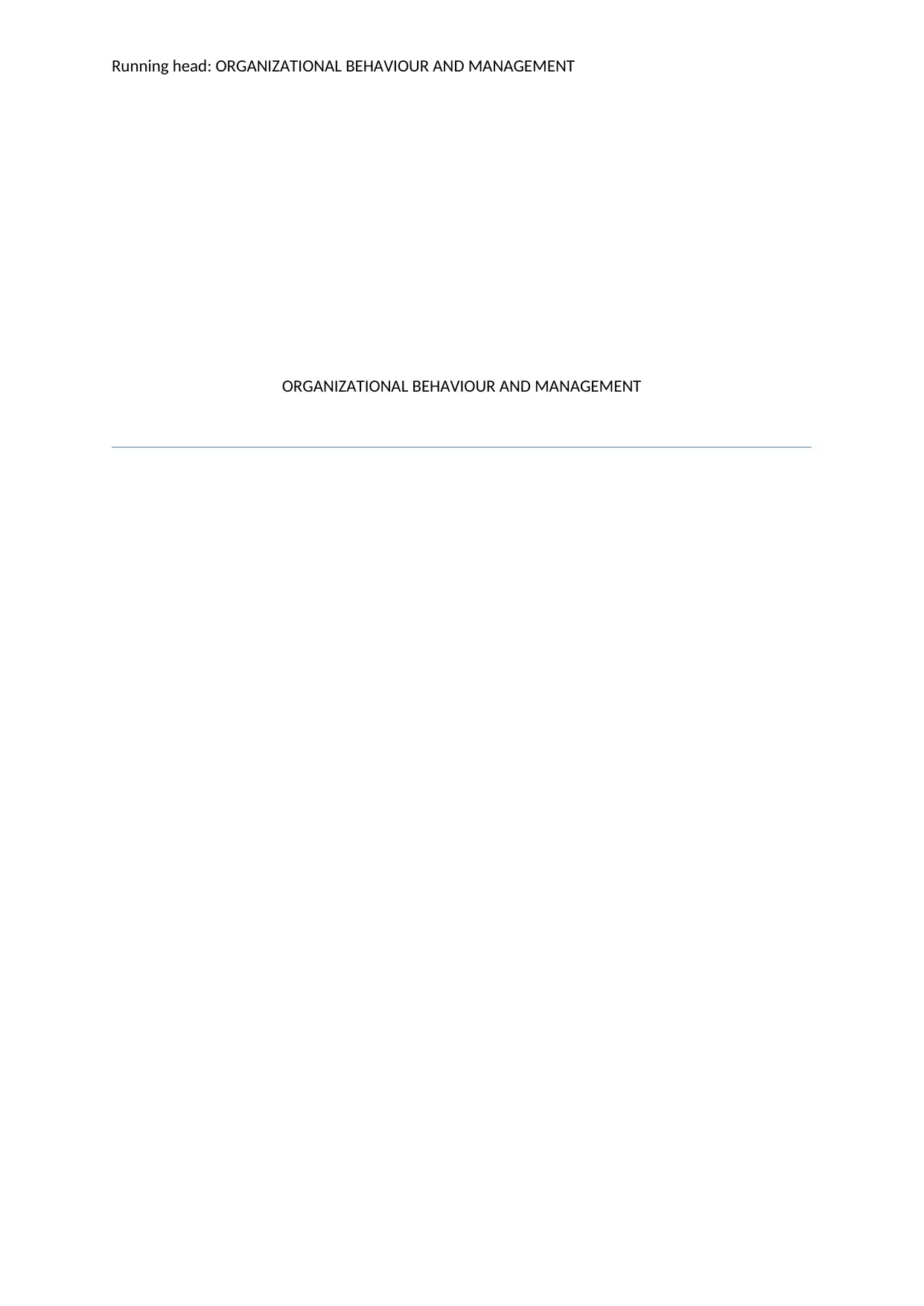
Running head: ORGANIZATIONAL BEHAVIOUR AND MANAGEMENT
ORGANIZATIONAL BEHAVIOUR AND MANAGEMENT
ORGANIZATIONAL BEHAVIOUR AND MANAGEMENT
Paraphrase This Document
Need a fresh take? Get an instant paraphrase of this document with our AI Paraphraser
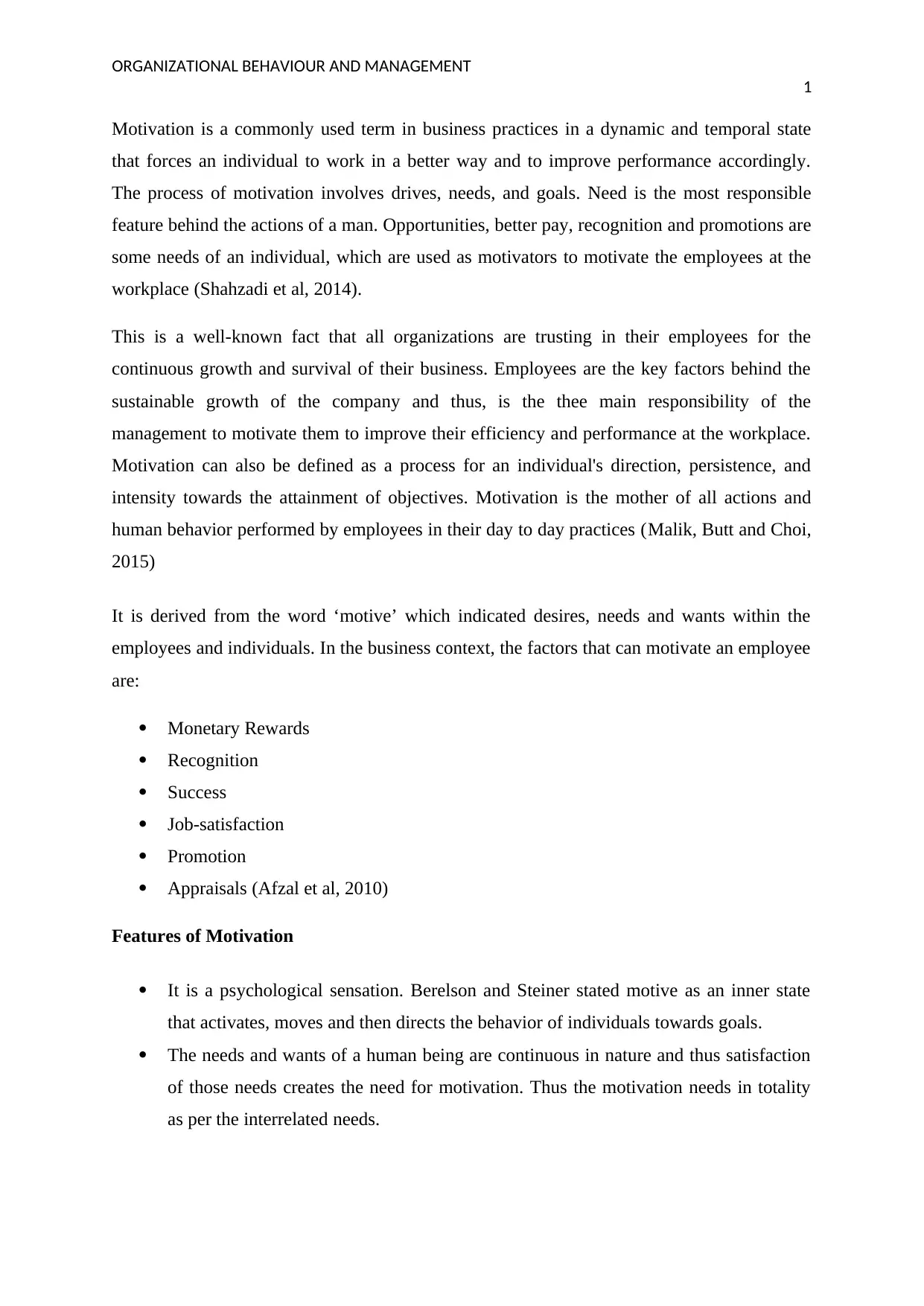
ORGANIZATIONAL BEHAVIOUR AND MANAGEMENT
1
Motivation is a commonly used term in business practices in a dynamic and temporal state
that forces an individual to work in a better way and to improve performance accordingly.
The process of motivation involves drives, needs, and goals. Need is the most responsible
feature behind the actions of a man. Opportunities, better pay, recognition and promotions are
some needs of an individual, which are used as motivators to motivate the employees at the
workplace (Shahzadi et al, 2014).
This is a well-known fact that all organizations are trusting in their employees for the
continuous growth and survival of their business. Employees are the key factors behind the
sustainable growth of the company and thus, is the thee main responsibility of the
management to motivate them to improve their efficiency and performance at the workplace.
Motivation can also be defined as a process for an individual's direction, persistence, and
intensity towards the attainment of objectives. Motivation is the mother of all actions and
human behavior performed by employees in their day to day practices (Malik, Butt and Choi,
2015)
It is derived from the word ‘motive’ which indicated desires, needs and wants within the
employees and individuals. In the business context, the factors that can motivate an employee
are:
Monetary Rewards
Recognition
Success
Job-satisfaction
Promotion
Appraisals (Afzal et al, 2010)
Features of Motivation
It is a psychological sensation. Berelson and Steiner stated motive as an inner state
that activates, moves and then directs the behavior of individuals towards goals.
The needs and wants of a human being are continuous in nature and thus satisfaction
of those needs creates the need for motivation. Thus the motivation needs in totality
as per the interrelated needs.
1
Motivation is a commonly used term in business practices in a dynamic and temporal state
that forces an individual to work in a better way and to improve performance accordingly.
The process of motivation involves drives, needs, and goals. Need is the most responsible
feature behind the actions of a man. Opportunities, better pay, recognition and promotions are
some needs of an individual, which are used as motivators to motivate the employees at the
workplace (Shahzadi et al, 2014).
This is a well-known fact that all organizations are trusting in their employees for the
continuous growth and survival of their business. Employees are the key factors behind the
sustainable growth of the company and thus, is the thee main responsibility of the
management to motivate them to improve their efficiency and performance at the workplace.
Motivation can also be defined as a process for an individual's direction, persistence, and
intensity towards the attainment of objectives. Motivation is the mother of all actions and
human behavior performed by employees in their day to day practices (Malik, Butt and Choi,
2015)
It is derived from the word ‘motive’ which indicated desires, needs and wants within the
employees and individuals. In the business context, the factors that can motivate an employee
are:
Monetary Rewards
Recognition
Success
Job-satisfaction
Promotion
Appraisals (Afzal et al, 2010)
Features of Motivation
It is a psychological sensation. Berelson and Steiner stated motive as an inner state
that activates, moves and then directs the behavior of individuals towards goals.
The needs and wants of a human being are continuous in nature and thus satisfaction
of those needs creates the need for motivation. Thus the motivation needs in totality
as per the interrelated needs.
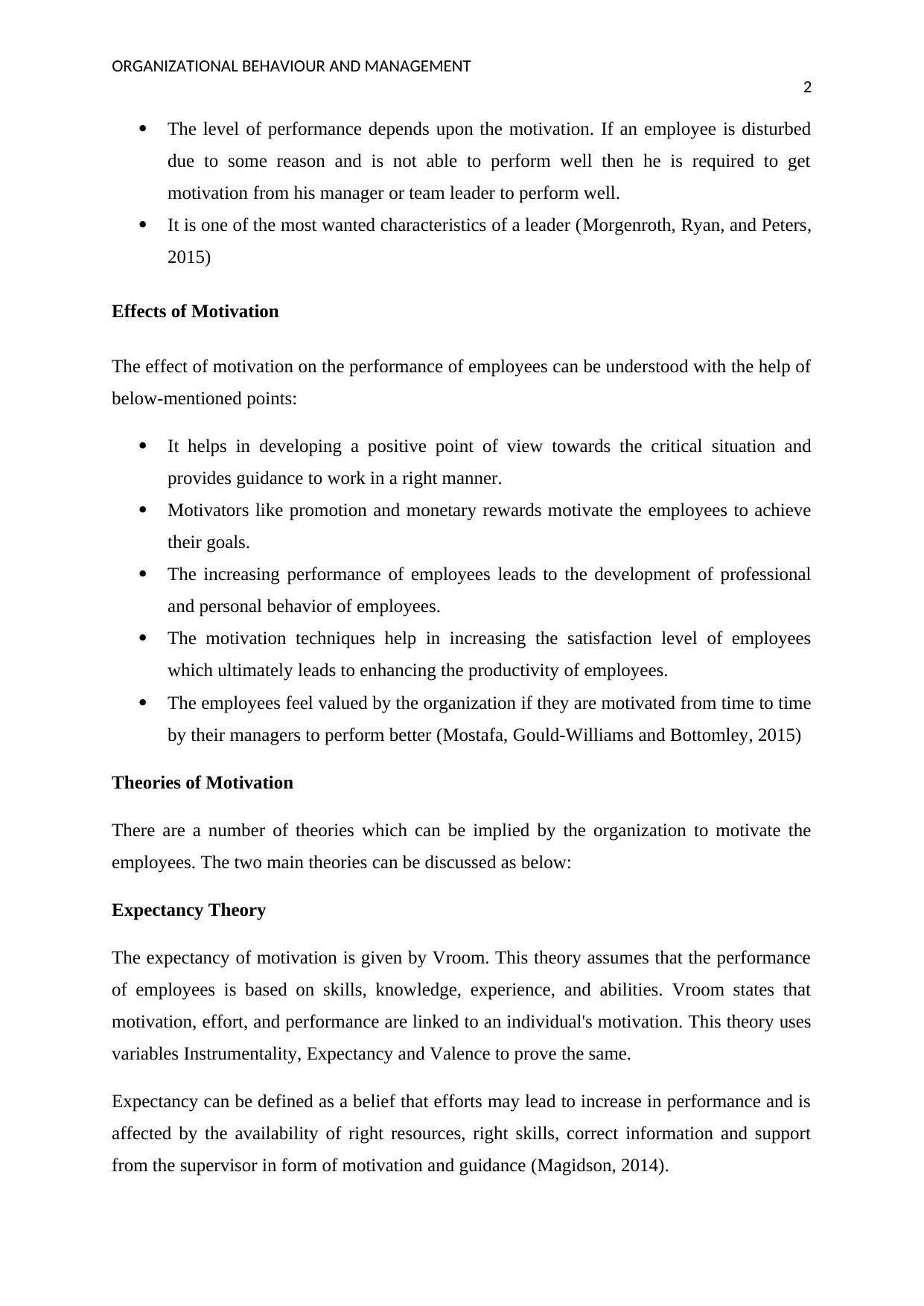
ORGANIZATIONAL BEHAVIOUR AND MANAGEMENT
2
The level of performance depends upon the motivation. If an employee is disturbed
due to some reason and is not able to perform well then he is required to get
motivation from his manager or team leader to perform well.
It is one of the most wanted characteristics of a leader (Morgenroth, Ryan, and Peters,
2015)
Effects of Motivation
The effect of motivation on the performance of employees can be understood with the help of
below-mentioned points:
It helps in developing a positive point of view towards the critical situation and
provides guidance to work in a right manner.
Motivators like promotion and monetary rewards motivate the employees to achieve
their goals.
The increasing performance of employees leads to the development of professional
and personal behavior of employees.
The motivation techniques help in increasing the satisfaction level of employees
which ultimately leads to enhancing the productivity of employees.
The employees feel valued by the organization if they are motivated from time to time
by their managers to perform better (Mostafa, Gould‐Williams and Bottomley, 2015)
Theories of Motivation
There are a number of theories which can be implied by the organization to motivate the
employees. The two main theories can be discussed as below:
Expectancy Theory
The expectancy of motivation is given by Vroom. This theory assumes that the performance
of employees is based on skills, knowledge, experience, and abilities. Vroom states that
motivation, effort, and performance are linked to an individual's motivation. This theory uses
variables Instrumentality, Expectancy and Valence to prove the same.
Expectancy can be defined as a belief that efforts may lead to increase in performance and is
affected by the availability of right resources, right skills, correct information and support
from the supervisor in form of motivation and guidance (Magidson, 2014).
2
The level of performance depends upon the motivation. If an employee is disturbed
due to some reason and is not able to perform well then he is required to get
motivation from his manager or team leader to perform well.
It is one of the most wanted characteristics of a leader (Morgenroth, Ryan, and Peters,
2015)
Effects of Motivation
The effect of motivation on the performance of employees can be understood with the help of
below-mentioned points:
It helps in developing a positive point of view towards the critical situation and
provides guidance to work in a right manner.
Motivators like promotion and monetary rewards motivate the employees to achieve
their goals.
The increasing performance of employees leads to the development of professional
and personal behavior of employees.
The motivation techniques help in increasing the satisfaction level of employees
which ultimately leads to enhancing the productivity of employees.
The employees feel valued by the organization if they are motivated from time to time
by their managers to perform better (Mostafa, Gould‐Williams and Bottomley, 2015)
Theories of Motivation
There are a number of theories which can be implied by the organization to motivate the
employees. The two main theories can be discussed as below:
Expectancy Theory
The expectancy of motivation is given by Vroom. This theory assumes that the performance
of employees is based on skills, knowledge, experience, and abilities. Vroom states that
motivation, effort, and performance are linked to an individual's motivation. This theory uses
variables Instrumentality, Expectancy and Valence to prove the same.
Expectancy can be defined as a belief that efforts may lead to increase in performance and is
affected by the availability of right resources, right skills, correct information and support
from the supervisor in form of motivation and guidance (Magidson, 2014).
⊘ This is a preview!⊘
Do you want full access?
Subscribe today to unlock all pages.

Trusted by 1+ million students worldwide
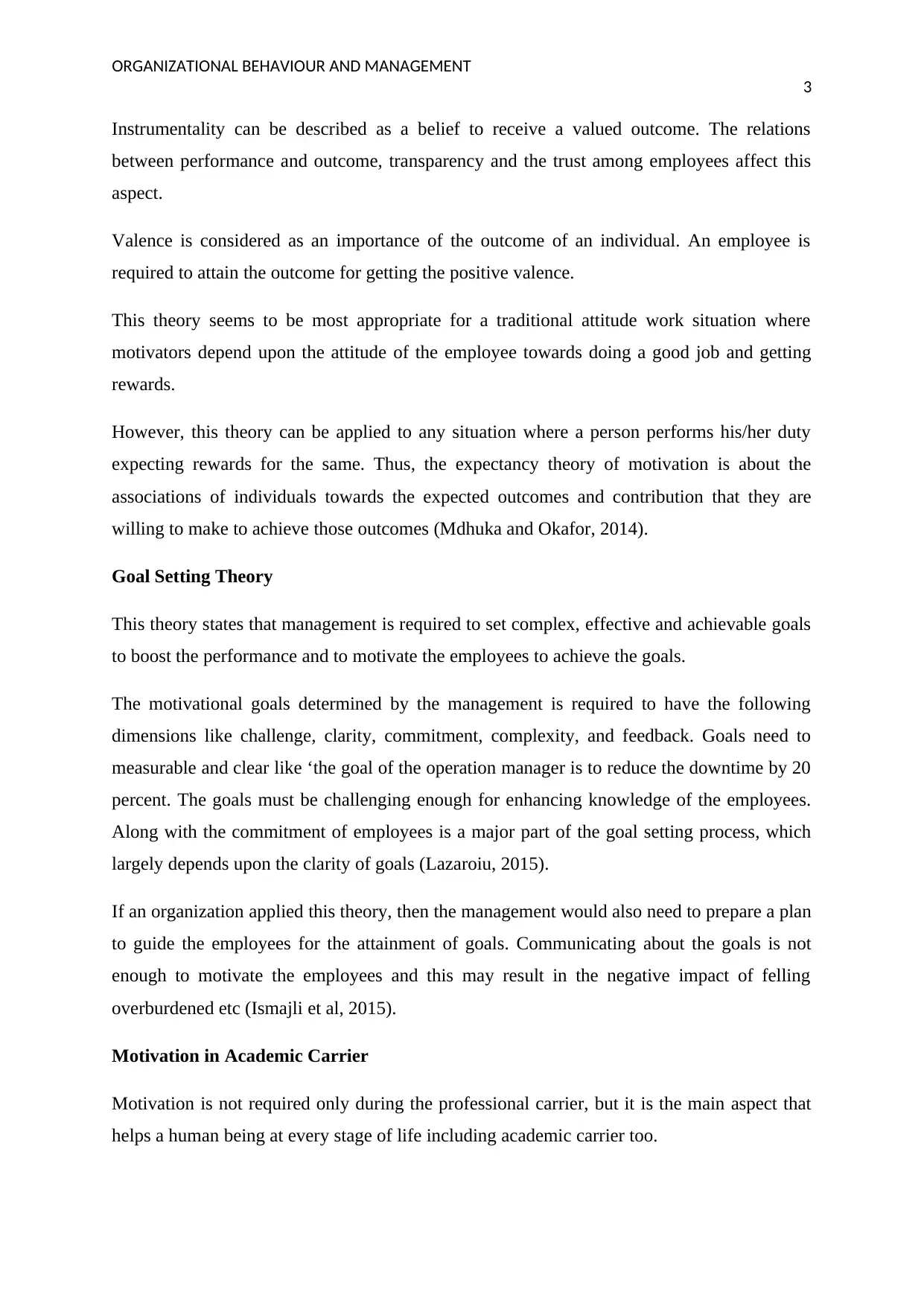
ORGANIZATIONAL BEHAVIOUR AND MANAGEMENT
3
Instrumentality can be described as a belief to receive a valued outcome. The relations
between performance and outcome, transparency and the trust among employees affect this
aspect.
Valence is considered as an importance of the outcome of an individual. An employee is
required to attain the outcome for getting the positive valence.
This theory seems to be most appropriate for a traditional attitude work situation where
motivators depend upon the attitude of the employee towards doing a good job and getting
rewards.
However, this theory can be applied to any situation where a person performs his/her duty
expecting rewards for the same. Thus, the expectancy theory of motivation is about the
associations of individuals towards the expected outcomes and contribution that they are
willing to make to achieve those outcomes (Mdhuka and Okafor, 2014).
Goal Setting Theory
This theory states that management is required to set complex, effective and achievable goals
to boost the performance and to motivate the employees to achieve the goals.
The motivational goals determined by the management is required to have the following
dimensions like challenge, clarity, commitment, complexity, and feedback. Goals need to
measurable and clear like ‘the goal of the operation manager is to reduce the downtime by 20
percent. The goals must be challenging enough for enhancing knowledge of the employees.
Along with the commitment of employees is a major part of the goal setting process, which
largely depends upon the clarity of goals (Lazaroiu, 2015).
If an organization applied this theory, then the management would also need to prepare a plan
to guide the employees for the attainment of goals. Communicating about the goals is not
enough to motivate the employees and this may result in the negative impact of felling
overburdened etc (Ismajli et al, 2015).
Motivation in Academic Carrier
Motivation is not required only during the professional carrier, but it is the main aspect that
helps a human being at every stage of life including academic carrier too.
3
Instrumentality can be described as a belief to receive a valued outcome. The relations
between performance and outcome, transparency and the trust among employees affect this
aspect.
Valence is considered as an importance of the outcome of an individual. An employee is
required to attain the outcome for getting the positive valence.
This theory seems to be most appropriate for a traditional attitude work situation where
motivators depend upon the attitude of the employee towards doing a good job and getting
rewards.
However, this theory can be applied to any situation where a person performs his/her duty
expecting rewards for the same. Thus, the expectancy theory of motivation is about the
associations of individuals towards the expected outcomes and contribution that they are
willing to make to achieve those outcomes (Mdhuka and Okafor, 2014).
Goal Setting Theory
This theory states that management is required to set complex, effective and achievable goals
to boost the performance and to motivate the employees to achieve the goals.
The motivational goals determined by the management is required to have the following
dimensions like challenge, clarity, commitment, complexity, and feedback. Goals need to
measurable and clear like ‘the goal of the operation manager is to reduce the downtime by 20
percent. The goals must be challenging enough for enhancing knowledge of the employees.
Along with the commitment of employees is a major part of the goal setting process, which
largely depends upon the clarity of goals (Lazaroiu, 2015).
If an organization applied this theory, then the management would also need to prepare a plan
to guide the employees for the attainment of goals. Communicating about the goals is not
enough to motivate the employees and this may result in the negative impact of felling
overburdened etc (Ismajli et al, 2015).
Motivation in Academic Carrier
Motivation is not required only during the professional carrier, but it is the main aspect that
helps a human being at every stage of life including academic carrier too.
Paraphrase This Document
Need a fresh take? Get an instant paraphrase of this document with our AI Paraphraser
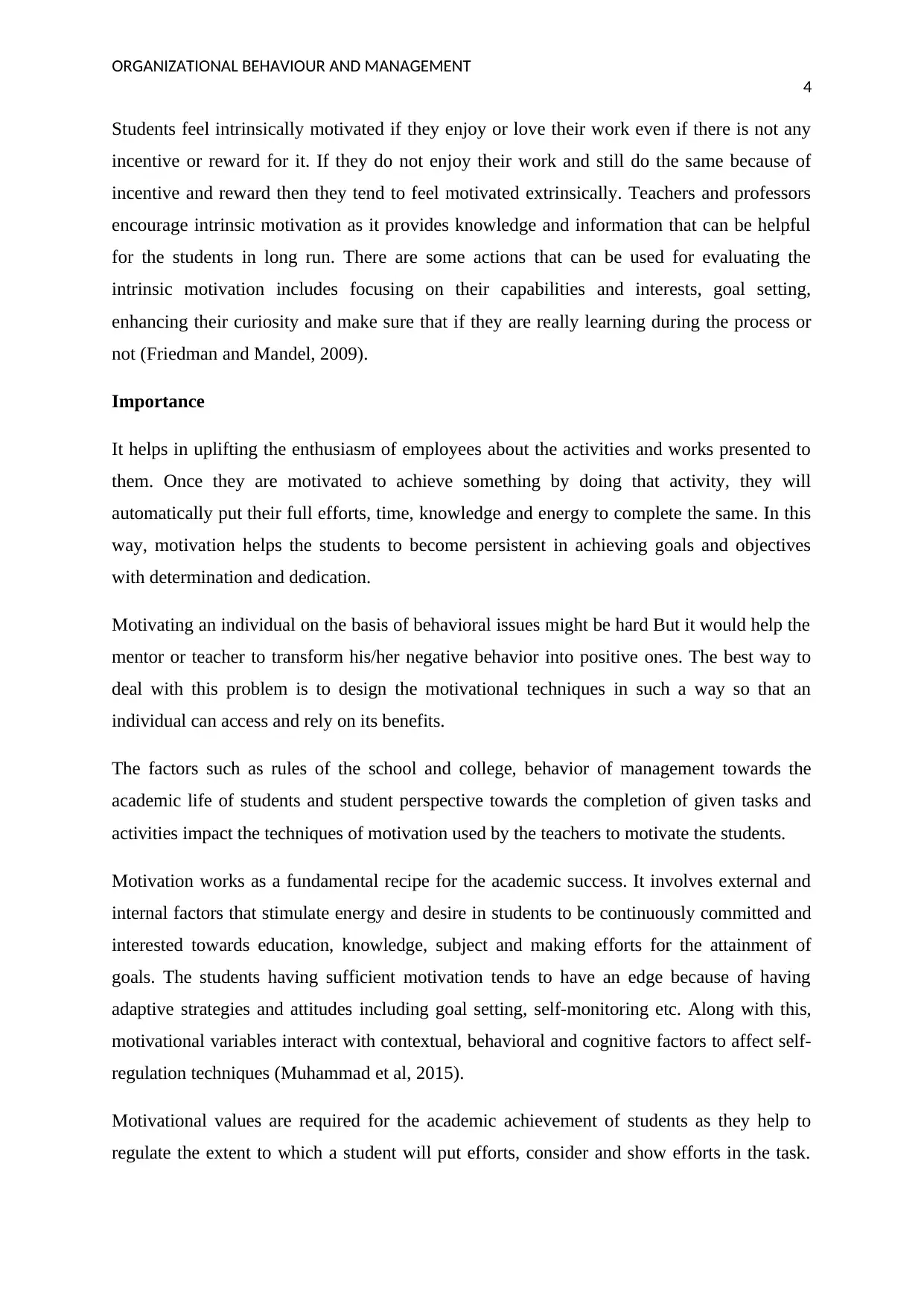
ORGANIZATIONAL BEHAVIOUR AND MANAGEMENT
4
Students feel intrinsically motivated if they enjoy or love their work even if there is not any
incentive or reward for it. If they do not enjoy their work and still do the same because of
incentive and reward then they tend to feel motivated extrinsically. Teachers and professors
encourage intrinsic motivation as it provides knowledge and information that can be helpful
for the students in long run. There are some actions that can be used for evaluating the
intrinsic motivation includes focusing on their capabilities and interests, goal setting,
enhancing their curiosity and make sure that if they are really learning during the process or
not (Friedman and Mandel, 2009).
Importance
It helps in uplifting the enthusiasm of employees about the activities and works presented to
them. Once they are motivated to achieve something by doing that activity, they will
automatically put their full efforts, time, knowledge and energy to complete the same. In this
way, motivation helps the students to become persistent in achieving goals and objectives
with determination and dedication.
Motivating an individual on the basis of behavioral issues might be hard But it would help the
mentor or teacher to transform his/her negative behavior into positive ones. The best way to
deal with this problem is to design the motivational techniques in such a way so that an
individual can access and rely on its benefits.
The factors such as rules of the school and college, behavior of management towards the
academic life of students and student perspective towards the completion of given tasks and
activities impact the techniques of motivation used by the teachers to motivate the students.
Motivation works as a fundamental recipe for the academic success. It involves external and
internal factors that stimulate energy and desire in students to be continuously committed and
interested towards education, knowledge, subject and making efforts for the attainment of
goals. The students having sufficient motivation tends to have an edge because of having
adaptive strategies and attitudes including goal setting, self-monitoring etc. Along with this,
motivational variables interact with contextual, behavioral and cognitive factors to affect self-
regulation techniques (Muhammad et al, 2015).
Motivational values are required for the academic achievement of students as they help to
regulate the extent to which a student will put efforts, consider and show efforts in the task.
4
Students feel intrinsically motivated if they enjoy or love their work even if there is not any
incentive or reward for it. If they do not enjoy their work and still do the same because of
incentive and reward then they tend to feel motivated extrinsically. Teachers and professors
encourage intrinsic motivation as it provides knowledge and information that can be helpful
for the students in long run. There are some actions that can be used for evaluating the
intrinsic motivation includes focusing on their capabilities and interests, goal setting,
enhancing their curiosity and make sure that if they are really learning during the process or
not (Friedman and Mandel, 2009).
Importance
It helps in uplifting the enthusiasm of employees about the activities and works presented to
them. Once they are motivated to achieve something by doing that activity, they will
automatically put their full efforts, time, knowledge and energy to complete the same. In this
way, motivation helps the students to become persistent in achieving goals and objectives
with determination and dedication.
Motivating an individual on the basis of behavioral issues might be hard But it would help the
mentor or teacher to transform his/her negative behavior into positive ones. The best way to
deal with this problem is to design the motivational techniques in such a way so that an
individual can access and rely on its benefits.
The factors such as rules of the school and college, behavior of management towards the
academic life of students and student perspective towards the completion of given tasks and
activities impact the techniques of motivation used by the teachers to motivate the students.
Motivation works as a fundamental recipe for the academic success. It involves external and
internal factors that stimulate energy and desire in students to be continuously committed and
interested towards education, knowledge, subject and making efforts for the attainment of
goals. The students having sufficient motivation tends to have an edge because of having
adaptive strategies and attitudes including goal setting, self-monitoring etc. Along with this,
motivational variables interact with contextual, behavioral and cognitive factors to affect self-
regulation techniques (Muhammad et al, 2015).
Motivational values are required for the academic achievement of students as they help to
regulate the extent to which a student will put efforts, consider and show efforts in the task.
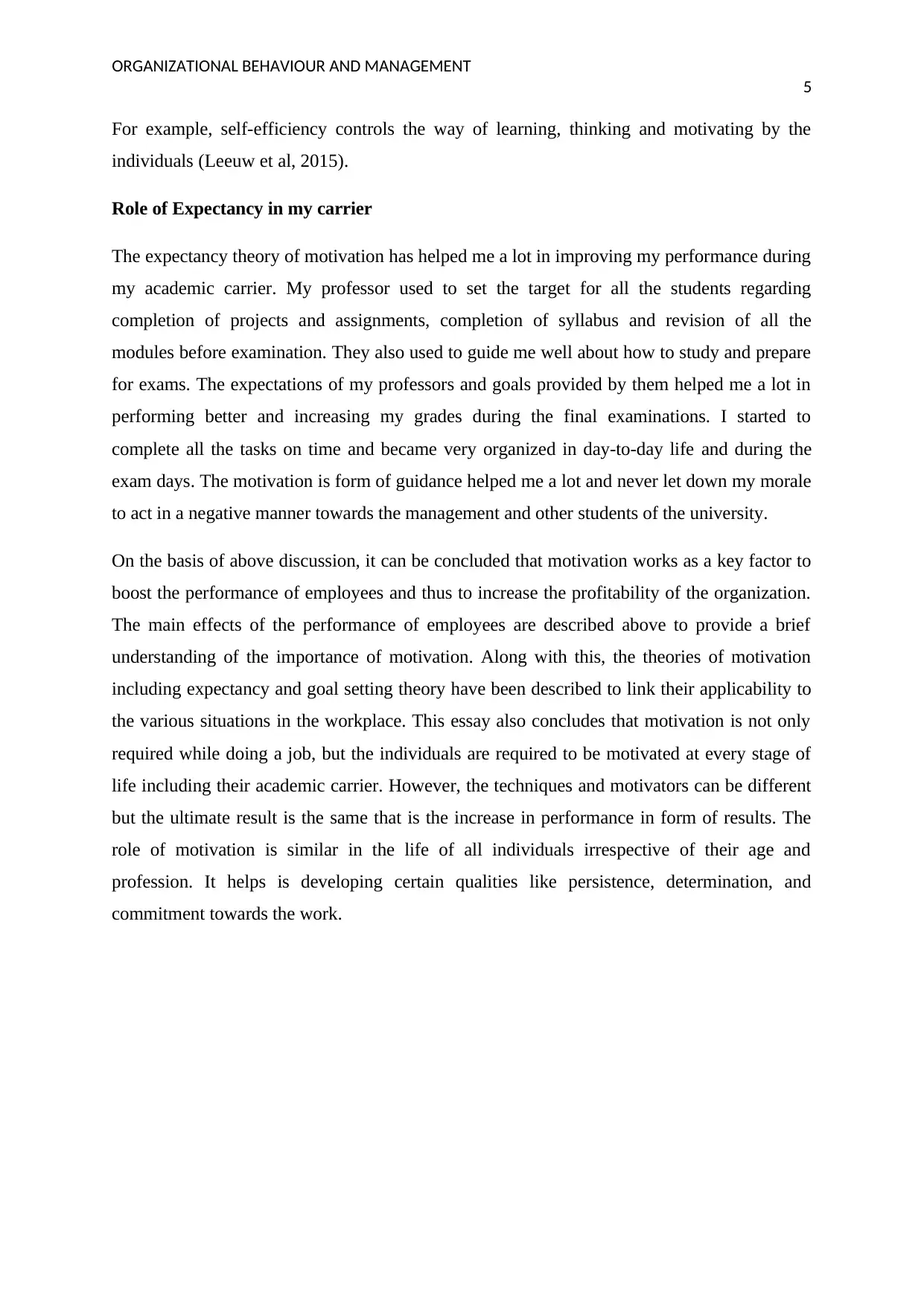
ORGANIZATIONAL BEHAVIOUR AND MANAGEMENT
5
For example, self-efficiency controls the way of learning, thinking and motivating by the
individuals (Leeuw et al, 2015).
Role of Expectancy in my carrier
The expectancy theory of motivation has helped me a lot in improving my performance during
my academic carrier. My professor used to set the target for all the students regarding
completion of projects and assignments, completion of syllabus and revision of all the
modules before examination. They also used to guide me well about how to study and prepare
for exams. The expectations of my professors and goals provided by them helped me a lot in
performing better and increasing my grades during the final examinations. I started to
complete all the tasks on time and became very organized in day-to-day life and during the
exam days. The motivation is form of guidance helped me a lot and never let down my morale
to act in a negative manner towards the management and other students of the university.
On the basis of above discussion, it can be concluded that motivation works as a key factor to
boost the performance of employees and thus to increase the profitability of the organization.
The main effects of the performance of employees are described above to provide a brief
understanding of the importance of motivation. Along with this, the theories of motivation
including expectancy and goal setting theory have been described to link their applicability to
the various situations in the workplace. This essay also concludes that motivation is not only
required while doing a job, but the individuals are required to be motivated at every stage of
life including their academic carrier. However, the techniques and motivators can be different
but the ultimate result is the same that is the increase in performance in form of results. The
role of motivation is similar in the life of all individuals irrespective of their age and
profession. It helps is developing certain qualities like persistence, determination, and
commitment towards the work.
5
For example, self-efficiency controls the way of learning, thinking and motivating by the
individuals (Leeuw et al, 2015).
Role of Expectancy in my carrier
The expectancy theory of motivation has helped me a lot in improving my performance during
my academic carrier. My professor used to set the target for all the students regarding
completion of projects and assignments, completion of syllabus and revision of all the
modules before examination. They also used to guide me well about how to study and prepare
for exams. The expectations of my professors and goals provided by them helped me a lot in
performing better and increasing my grades during the final examinations. I started to
complete all the tasks on time and became very organized in day-to-day life and during the
exam days. The motivation is form of guidance helped me a lot and never let down my morale
to act in a negative manner towards the management and other students of the university.
On the basis of above discussion, it can be concluded that motivation works as a key factor to
boost the performance of employees and thus to increase the profitability of the organization.
The main effects of the performance of employees are described above to provide a brief
understanding of the importance of motivation. Along with this, the theories of motivation
including expectancy and goal setting theory have been described to link their applicability to
the various situations in the workplace. This essay also concludes that motivation is not only
required while doing a job, but the individuals are required to be motivated at every stage of
life including their academic carrier. However, the techniques and motivators can be different
but the ultimate result is the same that is the increase in performance in form of results. The
role of motivation is similar in the life of all individuals irrespective of their age and
profession. It helps is developing certain qualities like persistence, determination, and
commitment towards the work.
⊘ This is a preview!⊘
Do you want full access?
Subscribe today to unlock all pages.

Trusted by 1+ million students worldwide
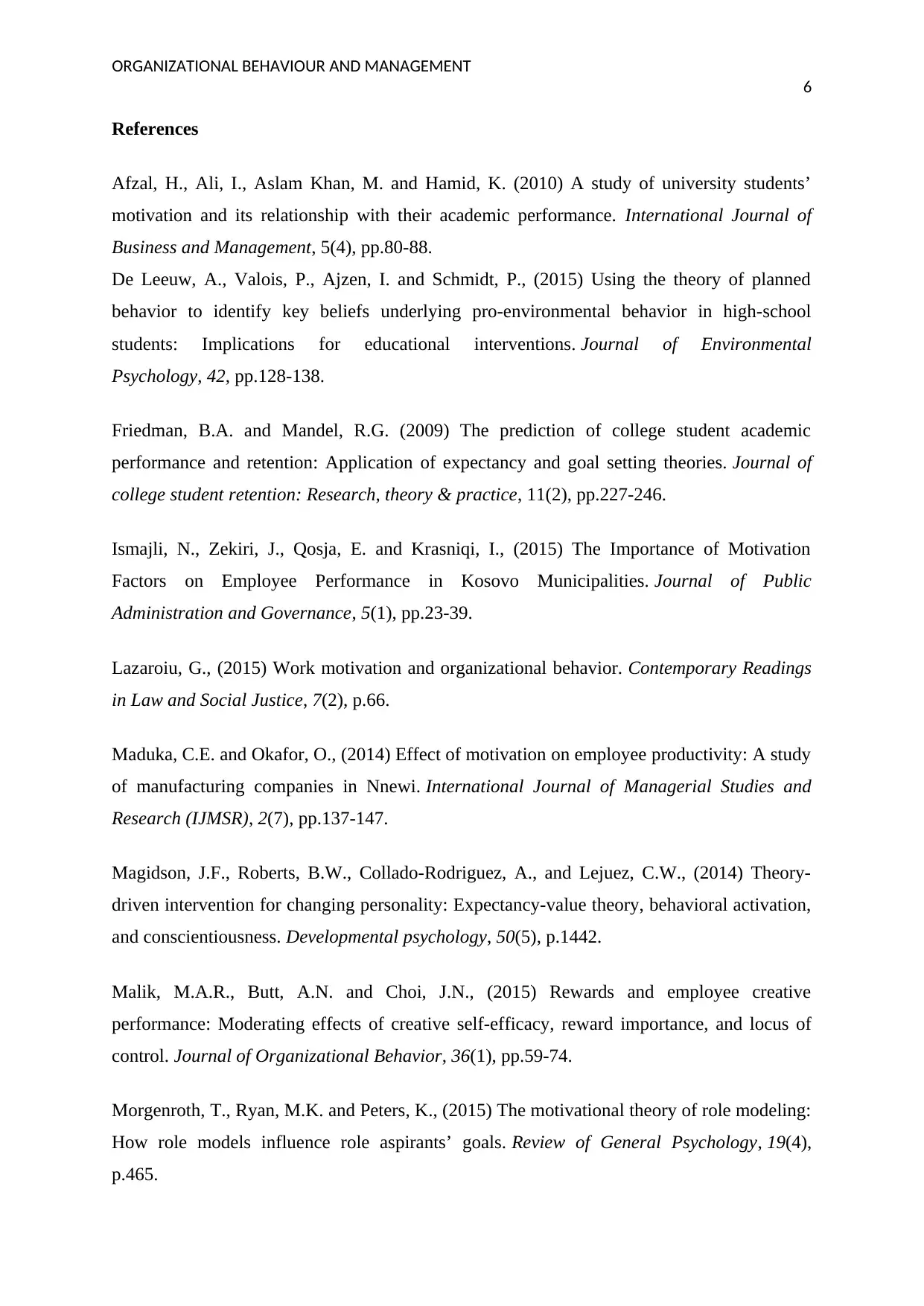
ORGANIZATIONAL BEHAVIOUR AND MANAGEMENT
6
References
Afzal, H., Ali, I., Aslam Khan, M. and Hamid, K. (2010) A study of university students’
motivation and its relationship with their academic performance. International Journal of
Business and Management, 5(4), pp.80-88.
De Leeuw, A., Valois, P., Ajzen, I. and Schmidt, P., (2015) Using the theory of planned
behavior to identify key beliefs underlying pro-environmental behavior in high-school
students: Implications for educational interventions. Journal of Environmental
Psychology, 42, pp.128-138.
Friedman, B.A. and Mandel, R.G. (2009) The prediction of college student academic
performance and retention: Application of expectancy and goal setting theories. Journal of
college student retention: Research, theory & practice, 11(2), pp.227-246.
Ismajli, N., Zekiri, J., Qosja, E. and Krasniqi, I., (2015) The Importance of Motivation
Factors on Employee Performance in Kosovo Municipalities. Journal of Public
Administration and Governance, 5(1), pp.23-39.
Lazaroiu, G., (2015) Work motivation and organizational behavior. Contemporary Readings
in Law and Social Justice, 7(2), p.66.
Maduka, C.E. and Okafor, O., (2014) Effect of motivation on employee productivity: A study
of manufacturing companies in Nnewi. International Journal of Managerial Studies and
Research (IJMSR), 2(7), pp.137-147.
Magidson, J.F., Roberts, B.W., Collado-Rodriguez, A., and Lejuez, C.W., (2014) Theory-
driven intervention for changing personality: Expectancy-value theory, behavioral activation,
and conscientiousness. Developmental psychology, 50(5), p.1442.
Malik, M.A.R., Butt, A.N. and Choi, J.N., (2015) Rewards and employee creative
performance: Moderating effects of creative self‐efficacy, reward importance, and locus of
control. Journal of Organizational Behavior, 36(1), pp.59-74.
Morgenroth, T., Ryan, M.K. and Peters, K., (2015) The motivational theory of role modeling:
How role models influence role aspirants’ goals. Review of General Psychology, 19(4),
p.465.
6
References
Afzal, H., Ali, I., Aslam Khan, M. and Hamid, K. (2010) A study of university students’
motivation and its relationship with their academic performance. International Journal of
Business and Management, 5(4), pp.80-88.
De Leeuw, A., Valois, P., Ajzen, I. and Schmidt, P., (2015) Using the theory of planned
behavior to identify key beliefs underlying pro-environmental behavior in high-school
students: Implications for educational interventions. Journal of Environmental
Psychology, 42, pp.128-138.
Friedman, B.A. and Mandel, R.G. (2009) The prediction of college student academic
performance and retention: Application of expectancy and goal setting theories. Journal of
college student retention: Research, theory & practice, 11(2), pp.227-246.
Ismajli, N., Zekiri, J., Qosja, E. and Krasniqi, I., (2015) The Importance of Motivation
Factors on Employee Performance in Kosovo Municipalities. Journal of Public
Administration and Governance, 5(1), pp.23-39.
Lazaroiu, G., (2015) Work motivation and organizational behavior. Contemporary Readings
in Law and Social Justice, 7(2), p.66.
Maduka, C.E. and Okafor, O., (2014) Effect of motivation on employee productivity: A study
of manufacturing companies in Nnewi. International Journal of Managerial Studies and
Research (IJMSR), 2(7), pp.137-147.
Magidson, J.F., Roberts, B.W., Collado-Rodriguez, A., and Lejuez, C.W., (2014) Theory-
driven intervention for changing personality: Expectancy-value theory, behavioral activation,
and conscientiousness. Developmental psychology, 50(5), p.1442.
Malik, M.A.R., Butt, A.N. and Choi, J.N., (2015) Rewards and employee creative
performance: Moderating effects of creative self‐efficacy, reward importance, and locus of
control. Journal of Organizational Behavior, 36(1), pp.59-74.
Morgenroth, T., Ryan, M.K. and Peters, K., (2015) The motivational theory of role modeling:
How role models influence role aspirants’ goals. Review of General Psychology, 19(4),
p.465.
Paraphrase This Document
Need a fresh take? Get an instant paraphrase of this document with our AI Paraphraser
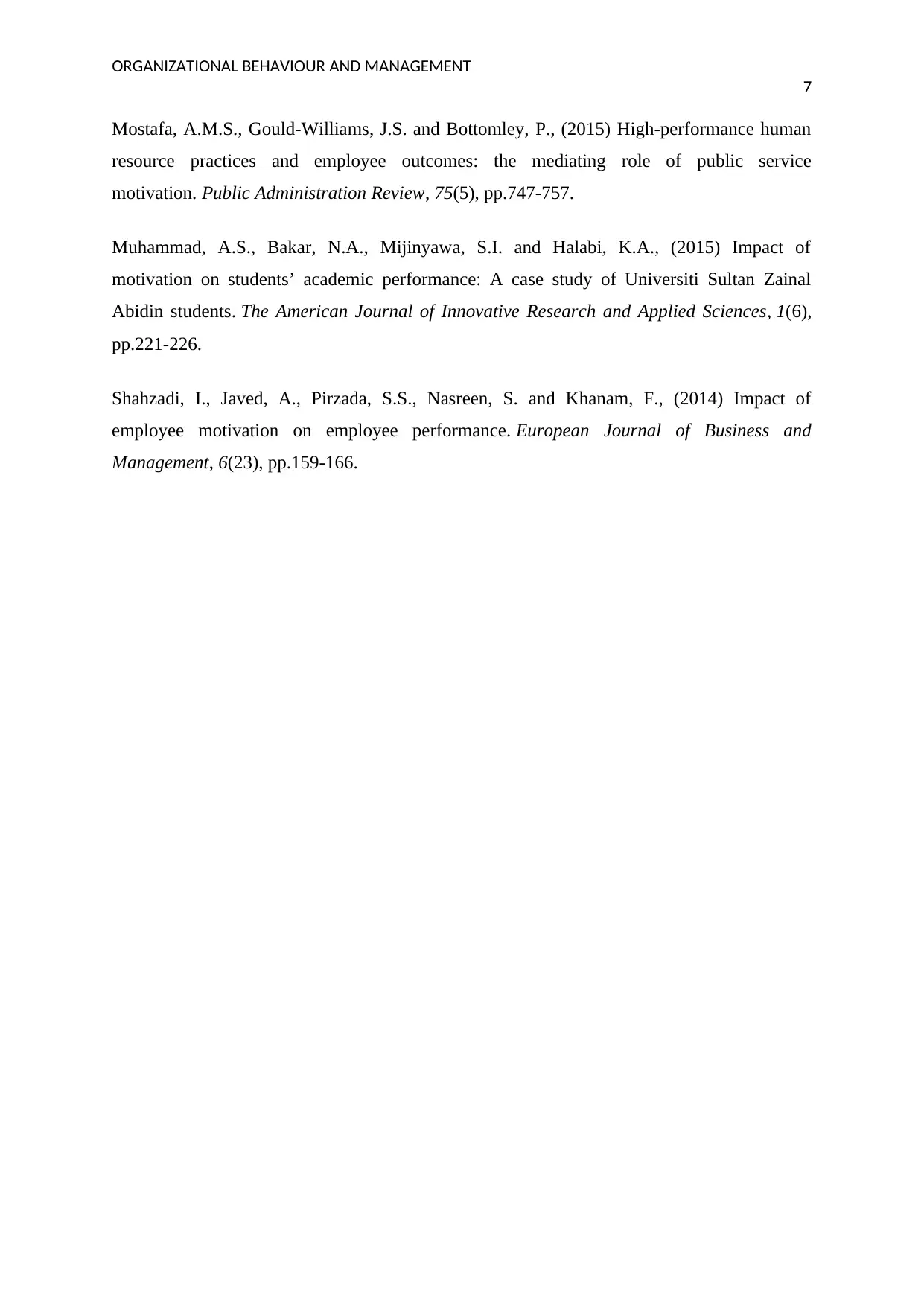
ORGANIZATIONAL BEHAVIOUR AND MANAGEMENT
7
Mostafa, A.M.S., Gould‐Williams, J.S. and Bottomley, P., (2015) High‐performance human
resource practices and employee outcomes: the mediating role of public service
motivation. Public Administration Review, 75(5), pp.747-757.
Muhammad, A.S., Bakar, N.A., Mijinyawa, S.I. and Halabi, K.A., (2015) Impact of
motivation on students’ academic performance: A case study of Universiti Sultan Zainal
Abidin students. The American Journal of Innovative Research and Applied Sciences, 1(6),
pp.221-226.
Shahzadi, I., Javed, A., Pirzada, S.S., Nasreen, S. and Khanam, F., (2014) Impact of
employee motivation on employee performance. European Journal of Business and
Management, 6(23), pp.159-166.
7
Mostafa, A.M.S., Gould‐Williams, J.S. and Bottomley, P., (2015) High‐performance human
resource practices and employee outcomes: the mediating role of public service
motivation. Public Administration Review, 75(5), pp.747-757.
Muhammad, A.S., Bakar, N.A., Mijinyawa, S.I. and Halabi, K.A., (2015) Impact of
motivation on students’ academic performance: A case study of Universiti Sultan Zainal
Abidin students. The American Journal of Innovative Research and Applied Sciences, 1(6),
pp.221-226.
Shahzadi, I., Javed, A., Pirzada, S.S., Nasreen, S. and Khanam, F., (2014) Impact of
employee motivation on employee performance. European Journal of Business and
Management, 6(23), pp.159-166.
1 out of 8
Related Documents
Your All-in-One AI-Powered Toolkit for Academic Success.
+13062052269
info@desklib.com
Available 24*7 on WhatsApp / Email
![[object Object]](/_next/static/media/star-bottom.7253800d.svg)
Unlock your academic potential
Copyright © 2020–2025 A2Z Services. All Rights Reserved. Developed and managed by ZUCOL.





